Wicked Wench

ADF:4 MR:3 DCR:38 Crew:up to 18
Armament: PLT (x2)
Defenses: RH
Communications/Detection: SubSpace Radio, Radar, Intercom (3 master panels, speaker/mike in each station/cabin/chamber)
Misc Equipment: Cargo Arm, Universal AirDock
Computer
(LVL:4 fp:135 SP:100)
Alarm (3)
Analysis (4)
Astrogation (4)
Commerce (1)
Communication (1)
Damage Control (3)
Drive - Atomic B (5)
Industry (1)
Information Storage (1)
Life Support cap:16 (1)
Maintenance (3)
Cargo Capacity:6
Crew Accomodations: Captain's Suite (1st class, double occupancy possible), 2 Crew Cabins w/2 triple bunks each, 2 officer cabins (double occupancy)
Ship's Vehicles: heavy fighter, 2 workpods
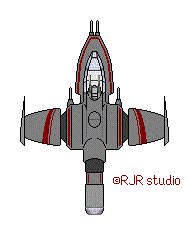

Wicked Wench deck 1: Bridge
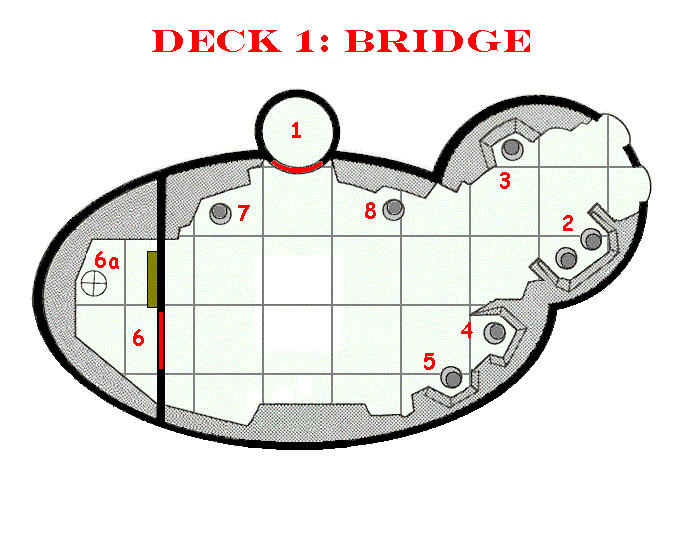
1> Central Elevator: the central elevator accesses all decks. It will take d10-3 turns to call the elevator (zero or less means the car is already on that deck), depending on what deck it was on last. Command officers (captain, pilots, engineers, astrogators, and gunnery officers) can halve that time by overriding the elevator with their ID (command officers have priority so the elevator won't stop at other decks while called upon). The elevator will sound an alarm tone when sensing a vaccuum outside, two buttons on opposite sides of the door must be pressed to open the door into a vaccuum (the elevator will depressurize and then open).
2> Pilot Station ***COMPUTER ACCESS*** command chairs for pilot and co-pilot, all piloting functions can be performed from either position. Also access to the ship's intercom, radar, and skin sensors.
3> Chief Engineer station ***COMPUTER ACCESS*** An engineer can direct and perform the Damage Control and Stress Analysis functions here.
4> Astrogator Station ***COMPUTER ACCESS*** An astrogator performs any/all astrogation functions here. A second astrogator can assist from the Computer Station nearby.
5> Computer Operator station ***COMPUTER ACCESS*** This is the primary control board for accessing the mainframe computer, all programs can be accessed from here. The Computer Operator can also assist the astrogator assuming he/she possesses the astrogation skills.
6> Mainframe Computer and Storage: any station marked ***COMPUTER ACCESS*** can tap into the mighty krays of the mainframe (access can be attained on the mainframe itself as well). 6a is a computer maintenance shaft access. Individual access stations can only access programs related to that station, for example the pilot station has access to all the piloting functions along with any other supporting systems, such as the ICM launcher and info storage and such, but not the engineering or astrogation programs. The lockers on the port bulkhead can store small arms, defensive suits, and other personal items.
7> Detection Officer: The officer positioned here has access to the radar and energy sensor, along with the skin sensors on the hull. This position can be eliminated for a skeleton crew, with these features manipulated by the pilot(s). The main radar is located on the other side of the hull from this station, the energy sensor is mounted further forward.
8> Communications Officer: the crew member positioned here operates the ship's subspace radio, videocom, and intercom. This position can be eliminated for a smaller crew, with these features manipulated by the pilot(s)
Wicked Wench deck 2: Officer Deck
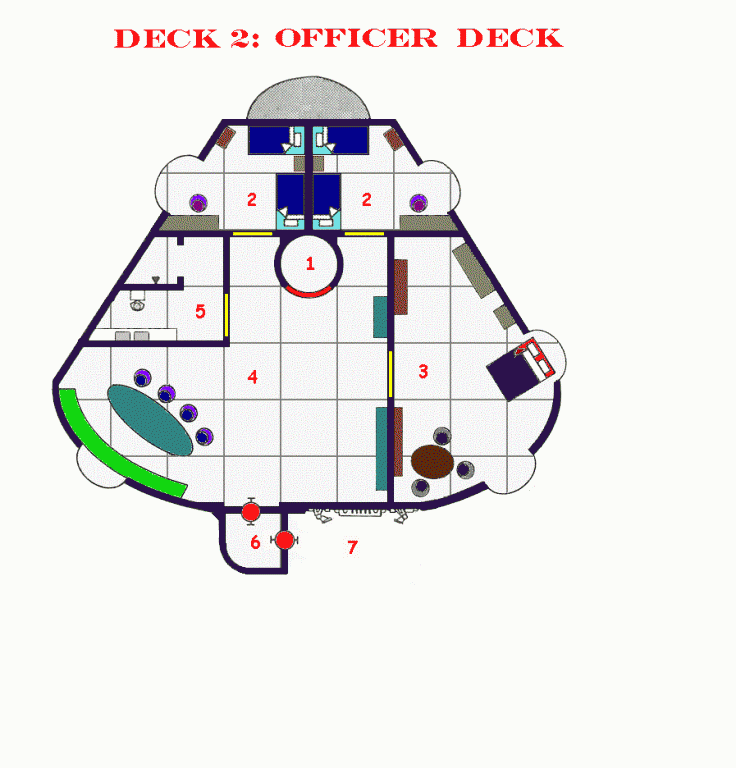
1> Central Elevator: the central elevator accesses all decks. It will take d10-3 turns to call the elevator (zero or less means the car is already on that deck), depending on what deck it was on last. Command officers (captain, pilots, engineers, astrogators, and gunnery officers) can halve that time by overriding the elevator with their ID (command officers have priority so the elevator won't stop at other decks while called upon). The elevator will sound an alarm tone when sensing a vaccuum outside, two buttons on opposite sides of the door must be pressed to open the door into a vaccuum (the elevator will depressurize and then open).
2> Officer Cabins: 2 single beds (modular, can be arranged as a double) along with wardrobes for two and a desk.
3> Captain's Cabin: one double bed positioned along the porthole compliments luxurious furnishing and decor, including wardrobes for two, a desk, and table w/three chairs.
4> Officers' Lounge: food is prepared and served from the crew galley on Deck 3. The spacious lounge has a table and chairs for 4, two more chairs can be added as needed. A holovid projector is available for entertainment purposes as well.
5> Fresher: toilet, 2 sinks, and a shower/steamroom
6> Airlock: this airlock is utilized to space-walk to the heavy fighter moored outside.
7> Fighter Mooring Dock: the Mourning Star is secured here when not in use. Space-walks to the dorsal access hatch on the fighter craft can be accomplished by the use of a detachable tether that connects the airlock to the fighter craft.
Wicked Wench deck 3: Crew Deck
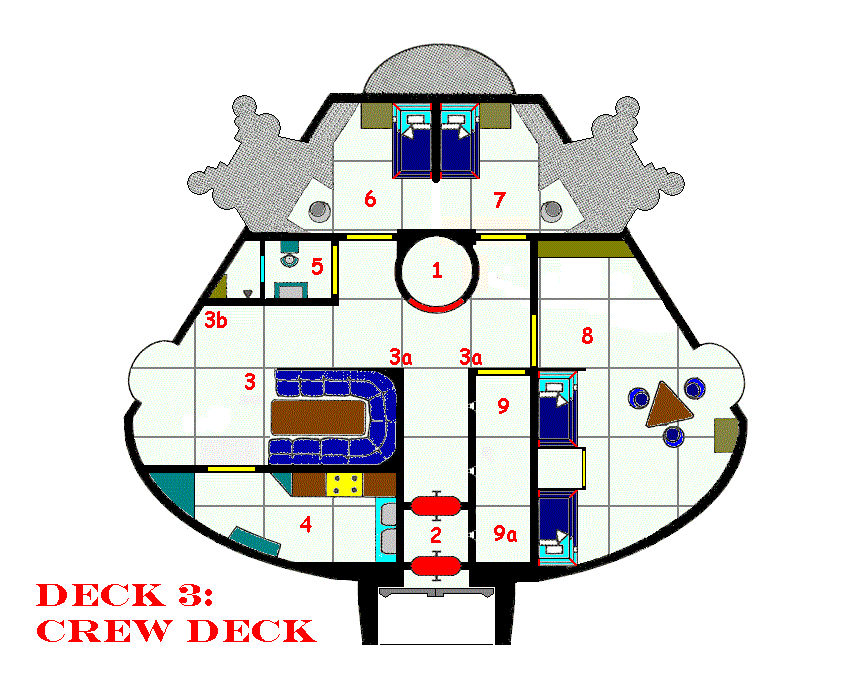
1> Central Elevator: the central elevator accesses all decks. It will take d10-3 turns to call the elevator (zero or less means the car is already on that deck), depending on what deck it was on last. Command officers (captain, pilots, engineers, astrogators, and gunnery officers) can halve that time by overriding the elevator with their ID (command officers have priority so the elevator won't stop at other decks while called upon). The elevator will sound an alarm tone when sensing a vaccuum outside, two buttons on opposite sides of the door must be pressed to open the door into a vaccuum (the elevator will depressurize and then open).
2> Universal Airdock/Airlock: all hatches are protected by security devices, and the pressure can be controlled within the airlock or overridden from the bridge at either the computer or pilot stations.
3> Crew Lounge: 3a> heavy weapon mounts, in the event of invasion armored sections slide out of the floor and cieling to protect the elevator and prevent harmful ricochet off the rounded surface for the concealed heavy weapon operators. 3b> Holovid projector, can also be used as a decoy for intruders.
4> Galley: all food storage and prep equipment is here, with capacity for ten day supply of fresh food concentrate (with the remainder of six months in the life support equipment on the Engineering Deck).
5> Fresher: contains a toilet, sink, and shower/steamroom for the crew.
6> Starboard Turret & Barracks: triple bunk allows for three crew members, along with the controls for the Starboard turret. Wardrobe cabinets for three.
7> Port Turret & Barracks: triple bunk allows for three crew members, along with the controls for the Port turret. Wardrobe cabinets for three.
8> Crew Barracks: two triple bunks allows for six crew members. Closet allows for four wardrobes along with another wardrobe for two on the port bulkhead and a dresser along the dorsal bulkehad. Table and chairs for three.
9> Storage Room: this is where larger items of personal interest can be stored by the crew members, including heavy weapons and space suits to ward off intruding boarders. 9a - gunports to airlock, any character utilizing these has a -40 modifier to be hit from intruders on the other side. Any character firing a weapon from a port can only shoot at beings in the 2 meter square on the other side, they can't shoot at beings in other port ranges. Any character on the other side can only shoot at port operators within said port range as well.
Wicked Wench deck 4: Engineering Deck
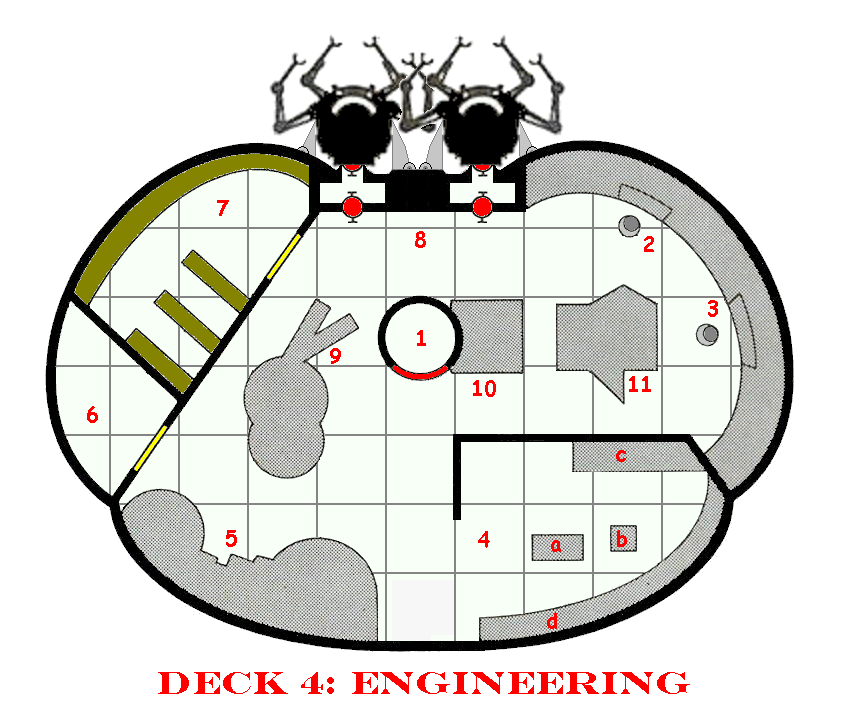
1> Central Elevator: the central elevator accesses all decks. It will take d10-3 turns to call the elevator (zero or less means the car is already on that deck), depending on what deck it was on last. Command officers (captain, pilots, engineers, astrogators, and gunnery officers) can halve that time by overriding the elevator with their ID (command officers have priority so the elevator won't stop at other decks while called upon).
2> Engineer's Station: ***COMPUTER ACCESS*** Panel and controls for monitoring the engines. Approximately half of the engine overhaul routine is spent at this station, with the other half in the engine room. Position can be eliminated for a smaller crew, with monitoring performed at the engineer station on the bridge.
3> Freight Handler Station: ***COMPUTER ACCESS*** Any technician w/LVL:3 Operate Machinery or higher can use this equipment to load or unload the cargo hold via the cargo arm, as well as opening or closing the bay doors.
4> Tool Room: a> Lase b> Drill Press c> Foundry d> tool cabinets
5> Life Support: regulates oxygen, air temperature, and food/water supply with a six month capacity for up to 20 persons, including the two 1st class occupants. Restocking the six month supply costs 750Cr.
6> Robot Closet
7> Storage Area: used for various small parts for the ship along with larger personal items, including spacesuits, armor, and rocketpacks and a LPT.
8> Workpod Bins: a pair of workpods is accsible via their respective airlocks.
9> Back-up Life Support: same as the main LS unit, with a second six month supply.
10> Power Relay Station: this unit transforms the energy from the atomic drives to electricity to run the various starship components via the generator located next to it. A large parabattery (equivillent to 10 type-4 parabatteries) can be used in emergency topower the primary systems in the event of engine failure or shut-down for up to 80 hours. This battery recharges once the drives are activated again, acquiring a full charge soon afterwards.
11> Generator
Wicked Wench deck 5: Cargo Hold
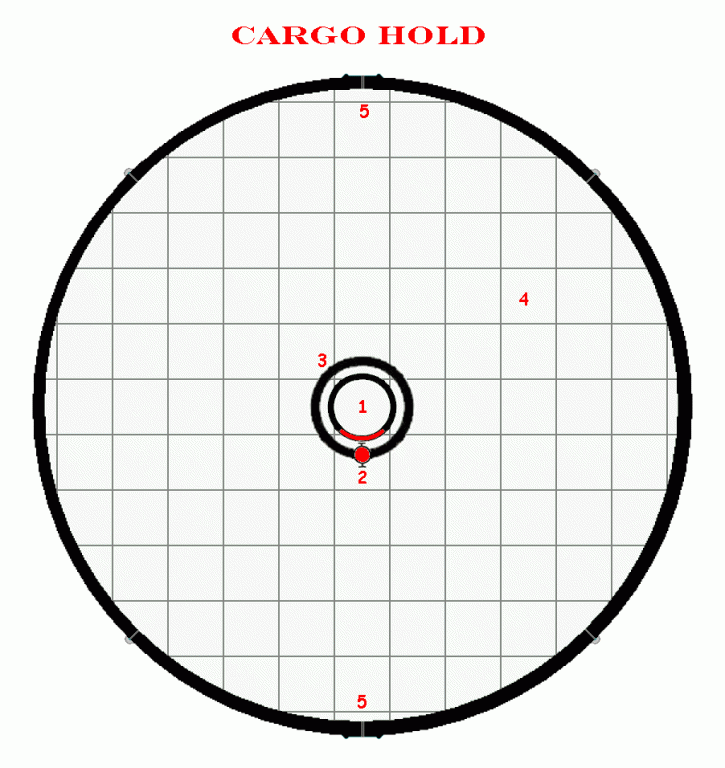
1> Central Elevator: the central elevator accesses all decks. It will take d10-3 turns to call the elevator (zero or less means the car is already on that deck), depending on what deck it was on last. Command officers (captain, pilots, engineers, astrogators, and gunnery officers) can halve that time by overriding the elevator with their ID (command officers have priority so the elevator won't stop at other decks while called upon). The elevator will sound an alarm tone when sensing a vaccuum outside, two buttons on opposite sides of the door must be pressed to open the door into a vaccuum (the elevator will depressurize and then open). 2> Cargo Hold Elevator Airlock: there are two such accessways into the hold, one on each end of the hold (floor and cieling). The pressure can be controlled in each airlock or overridden in the bridge. 3> The Cargo Arm travels along this entire reinforced outer shell of the elevator shaft. 4> Cargo Hold: this section is tiered into five sections for ease in cargo loading and location. The hold can be pressurized, but only with both bay doors secured. Unless the hold is filled with unsealed/unprotected agricultural products, it is typically in a state of vaccuum to prevent loss of cargo in the event of combat. 5> Exterior Bay Doors: these can be opened from the Freight Handler Station on the Engineering Deck. Each set of bay doors open to expose a 90 degree cross section of the hull to allow cargo transfer. |
Wicked Wench deck 6: Engine Room
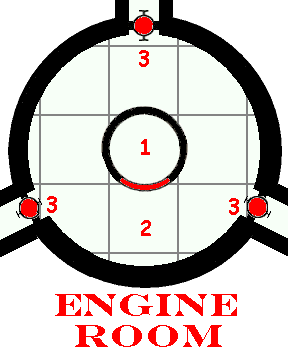
1> Central Elevator: the central elevator accesses all decks. It will take d10-3 turns to call the elevator (zero or less means the car is already on that deck), depending on what deck it was on last. Command officers (captain, pilots, engineers, astrogators, and gunnery officers) can halve that time by overriding the elevator with their ID (command officers have priority so the elevator won't stop at other decks while called upon). The elevator will sound an alarm tone when sensing a vaccuum outside, two buttons on opposite sides of the door must be pressed to open the door into a vaccuum (the elevator will depressurize and then open).
2> Parts and tool storage: there are cabinets along each wall for small parts and tools, along with monitoring gauges for each engine.
3> Engine Access: Each engine strut has a two part accessway, with an airlock/decontamination chamber followed by the access tunnel. These accessways slope down (at a 30 degree angle) and away from the hull.
Approximately 50% of the overhaul time will be spent in the engine room/accessways, with the remaining 50% in the Engineering Deck.